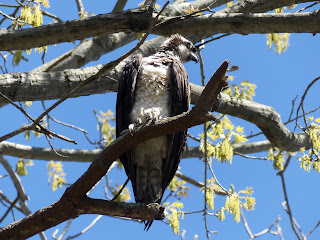Under an Osprey
Last week at the Washington Valley Reservoir a largish bird with white-and-dark contrast flew just past me onto a tree branch. My suspicions were quickly confirmed; this was an Osprey.
Similar to the nearby Duke Farms where I had also seen 1, I don't believe Ospreys ever nest here, though the reservoir can be a great place to grab a bite to eat before migrating elsewhere. I didn't see it catch a fish, though the abundance of human fishermen there suggests fish are plentiful.
As I typically do, I took the 1st relatively clear picture I could get, which in this case was almost directly under the Osprey. I feared that I might be too close for the Osprey's comfort, but the Osprey didn't seem very concerned about me as I moved further away to get a better angle. I have had some success getting Osprey pictures; some individuals seem to accept human activity in their vicinity. (I'm doubtful that a Bald Eagle would have been as accommodating.)
Ospreys are among several species of predatory bird that were greatly harmed by the use of DDT getting into the food chain. Though it didn't kill adult birds, they would produce eggshells so fragile that they broke before the chicks were ready to hatch. The Osprey population nosedived because so few chicks were surviving to adulthood. But with the DDT ban, our Ospreys have been making a strong comeback. It's status in New Jersey is still "imperiled" though.
Ospreys are fairly successful globally, living on all continents except (as with many other global species) Antarctica. They are taxonomic oddities though. We know they're neither hawks nor small eagles, though these may be the closest they come to having bird relatives.
 |
| May 9, 2022 at the Washington Valley Reservoir Photo 197981317, (c) jpviolette, some rights reserved (CC BY-NC) |
 |
| May 9, 2022 at the Washington Valley Reservoir Photo 197981222, (c) jpviolette, some rights reserved (CC BY-NC) |
 |
| May 9, 2022 at the Washington Valley Reservoir |



Comments
Post a Comment